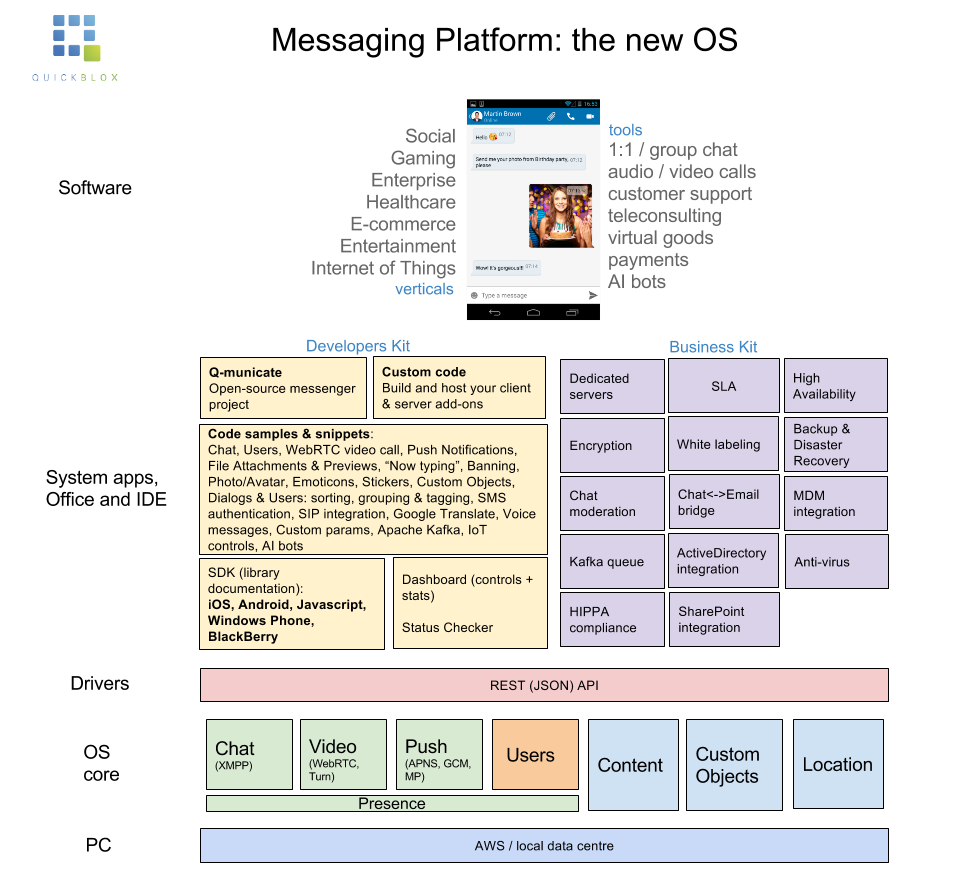So wanted to share some thoughts on the latest trend, the “messaging OS”.
Not sure if you noticed or not but as my business currently heavily involves OTT communication, I’m pretty sensitive to this stuff, also feels weird when something you’ve been telling your team and discussing internally suddenly becomes a topic of discussion on TechCrunch, in Mary Meeker reports etc.
So anyway, there are messaging platforms that enable you to add chat / video calling into your apps.
Some are around for a while, for example our QuickBlox has deployed first chat server for enterprise client back in 2011.
All of a sudden, however, people start calling these platforms the new Operational Systems.
Proof #1: check latest Mary Meeker report http://www.kpcb.com/internet-trends (slide 56)
Proof #2: and these TechCrunch posts:
So what does this all mean?
First, few words on background history enabling all this. You know like in school or low-level computer science paper you always have to start with “state-of-the-art” and how computers get better and better and why what you write about is relevant.
I’ll keep it to 2 sentences, how about that:
1. Infrastructures, operational systems and software got commoditised.
2. DevOps easily manage armies of images and buckets with the help of chefs and dockers.
3. Smartphone in your pocket is running a powerful multi-core Unix OS, a privilege of an expensive datacenter few years back.
OK so next, the problem. Or, rather, OPPORTUNITY. What’s remaining to figure out? What unites apps and their users?
Communication!
Yeah so we’ve figured out everything else – but only recently we started to get decent IM and calling for our hand-held devices.
And next step now is actually enable it everywhere!
Get it? Platforms handling messaging and data streaming are on their way to commoditisation too.
And this is going to be huge. You think there are too many messengers now? How about messenger in every app you use! How about your microwave and fridge, your home, your office and your current project each have their messenger avatar and each can message you and each other?
Simple case #1. A corporate worker is wondering why his internal employee finder app has to be so ugly. Why can’t it have nice chat bubbles, double-tick delivery statuses, avatars, “now typing”, emoticons and all those other sexy things every consumer user gets for free in their Whatsapp.
Simple case #2. Startup guy building another social network for Yorkshire terrier owners wants to build something quick, lean and mean. Sipping his smoothie, he wants to focus on UX and has neither time or patience to figure out each of these things separately: Database, JSON API, Users auth, XMPP chat server, Websockets, Presence, Push Notification alerts, File attachments, WebRTC, TURN, Facebook login, SMS verification, Web admin panel, Moderation and Ban API, iOS integration, Android integration, Javascript integration etc.
All this why end users getting mad there. End user doesn’t understand it takes a year to build backend before nice chat bubbles and alerts start appearing. They’ve tasted it elsewhere and now they want it in your product. They want it now. Otherwise they leave.
Enter mobile-first communication platforms.
It’s like an OS really:
1. PC. Bottom layer – hardware. In cloud era, AWS (or other IaaS) is your PC. This is simple.
2. OS core. Then you’ve got basic modules you can’t live without – users database, all those XMPP, websocket and TURN servers, push notification daemons and Kafka queues, data storage, all the interconnections and logic, so say when user is offline from chat (presence = 0) then send them a push notification alert using a custom template developer specified earlier via admin panel. So this is the logic, this is the core of your OS.
3. Drivers. So you have all that core logic but to expose it you need drivers. JSON API plays that role exposing all the services and modules.
4. System apps + IDE for developers. Bare-bone OS is useless. You need an ecosystem of apps, starting with pre-built system apps (dashboard) and an IDE (that’s what software engineers use to build new apps). So that’s your Developers Kit – in our case it’s everything to make that ‘app to WhatsApp’ transition 1) possible; 2) fast and reliable. That requires SDK libraries, code samples, documentation and all those code snippets / APIs implementing various functionalities end users need.
5. Office suite. To make business guys happy, you also need a bunch of other things, not necessary another software, it can be a service contract (SLA), certification of accordance (HIPPA compliance), a possibility to integrate with existing tools they have (MDM, SharePoint, ActiveDirectory), all things handling security, data ownership (dedicated / on-premise hosting).
And then you get the top layer. The visible part of the iceberg.
The messenger.
Or shall we say The Chat Box.
But really it’s like a pipe connecting you with other persons, things and bots elsewhere.
Oh and it’s slick out of the box, easy to use, intuitive, has nice chat bubbles and enables 1,000,000 other things through it such as:
- entertainment
- telemedicine
- e-commerce
- gaming
- IoT
So what has changed? Not much – just another revolution of technology.
Lots of stuff got commoditised. Picks and shovels got tossed away as developers got their own WhatsApp / Skype / Telegram cloning machines.
You don’t need that many clones of chat boxes right now. But you won’t imagine living without all those communication pipes few years from now.
Just remember those platforms silently running in background, like invisible titans holding this pipework for you to enjoy. And think – there is a new economy emerging where you can create your own “WhatsApp for X” in a matter of days, make a chat bot and sell it (yay cyber-slavery!); get free high quality video conferencing tech, overlay some crazy emoji and you’re big in Japan. It’s for you to figure out.

One thought on “Messaging OS”